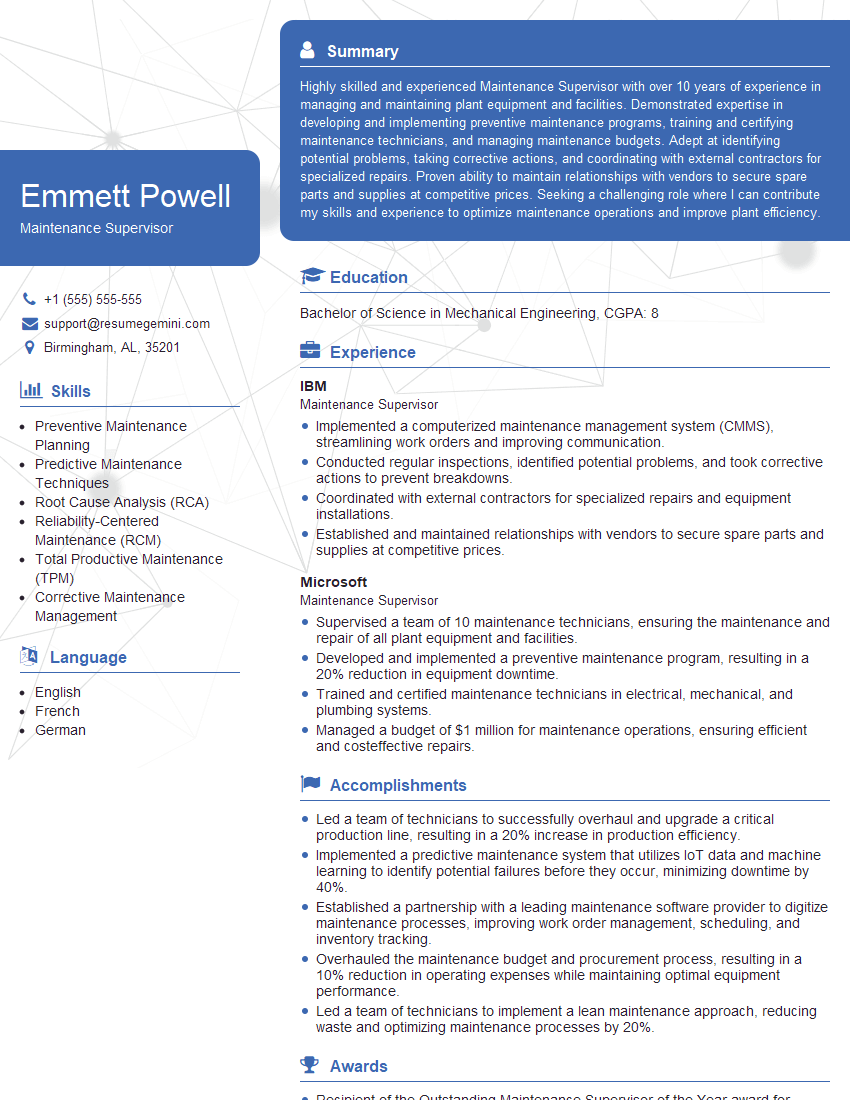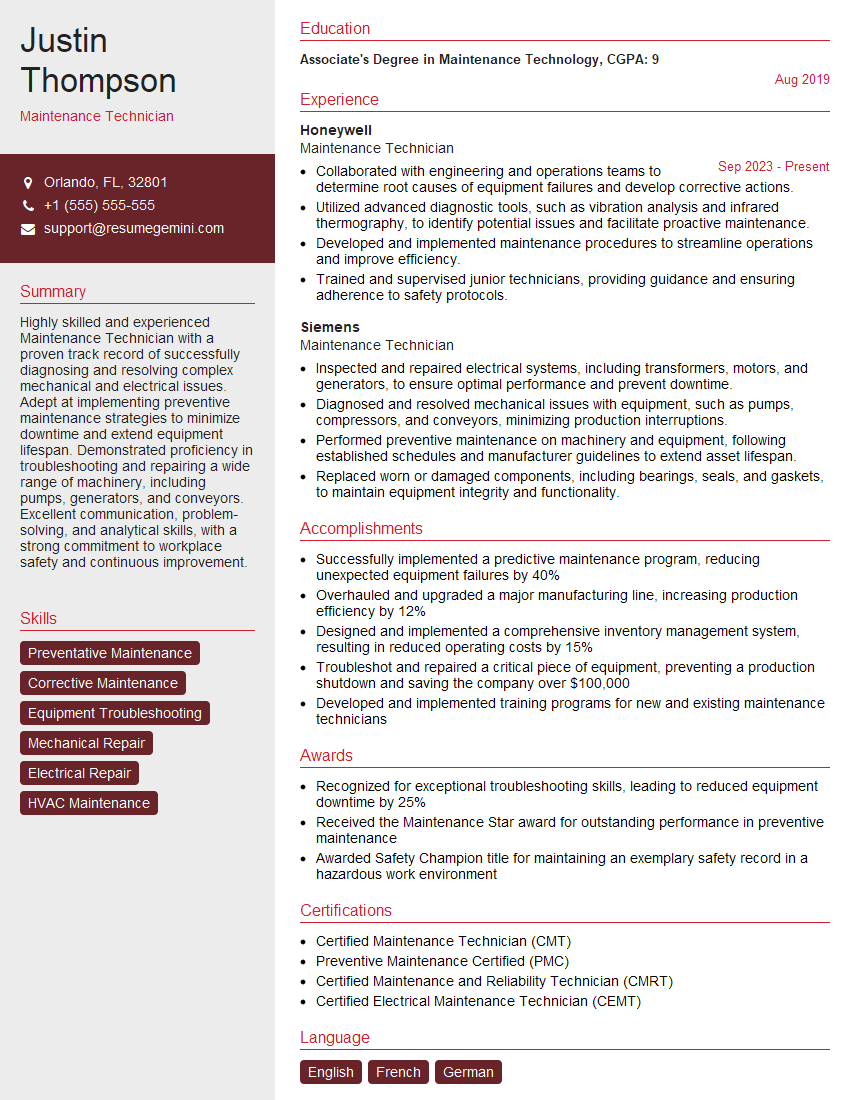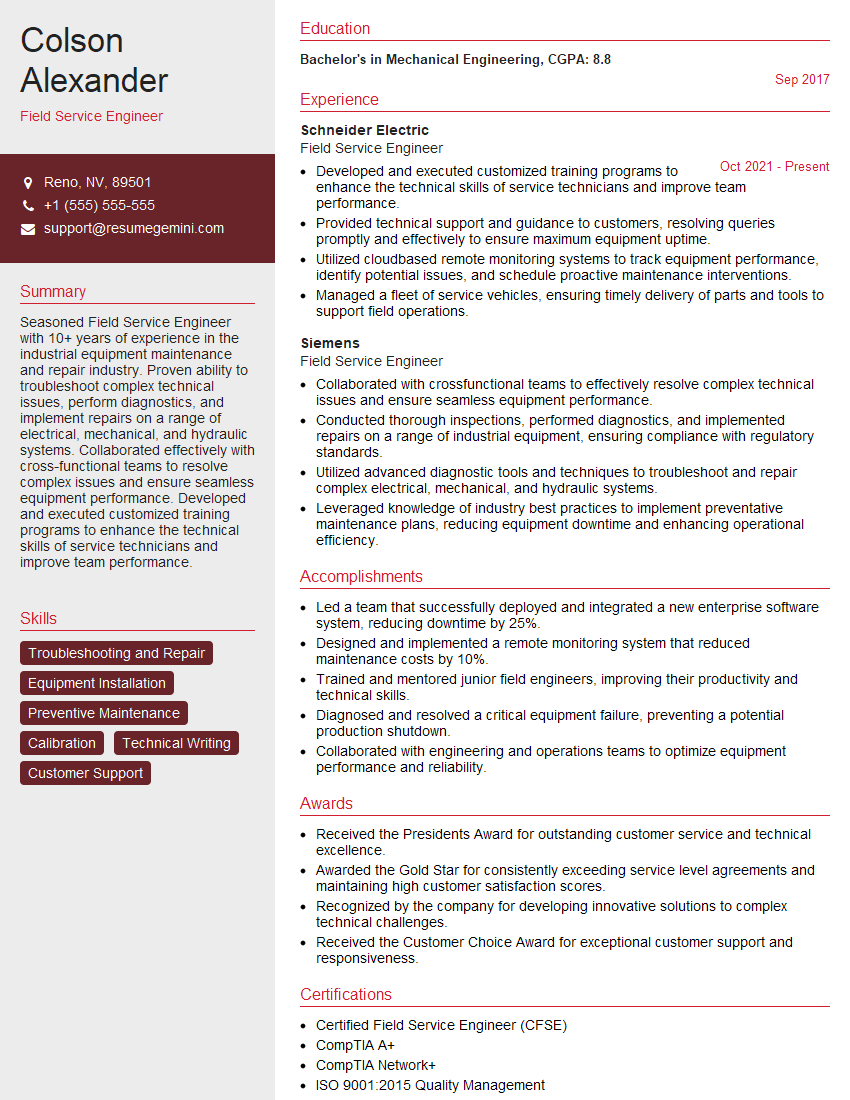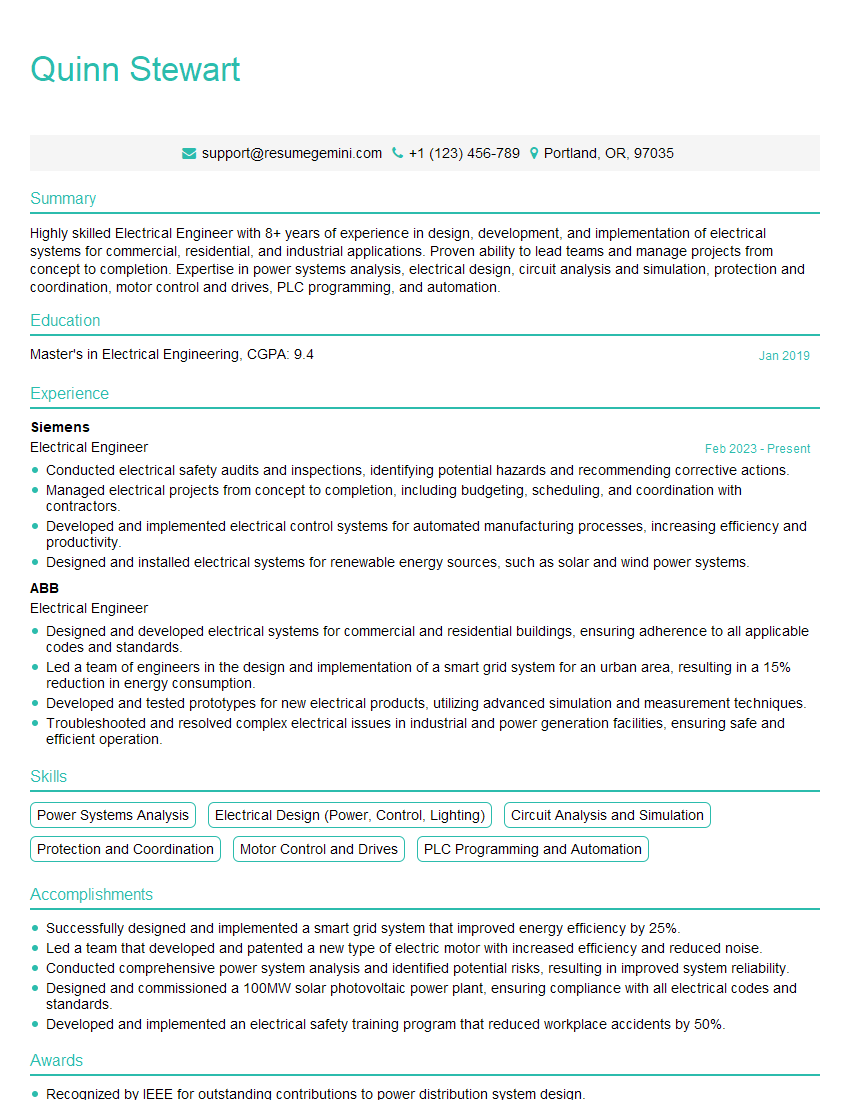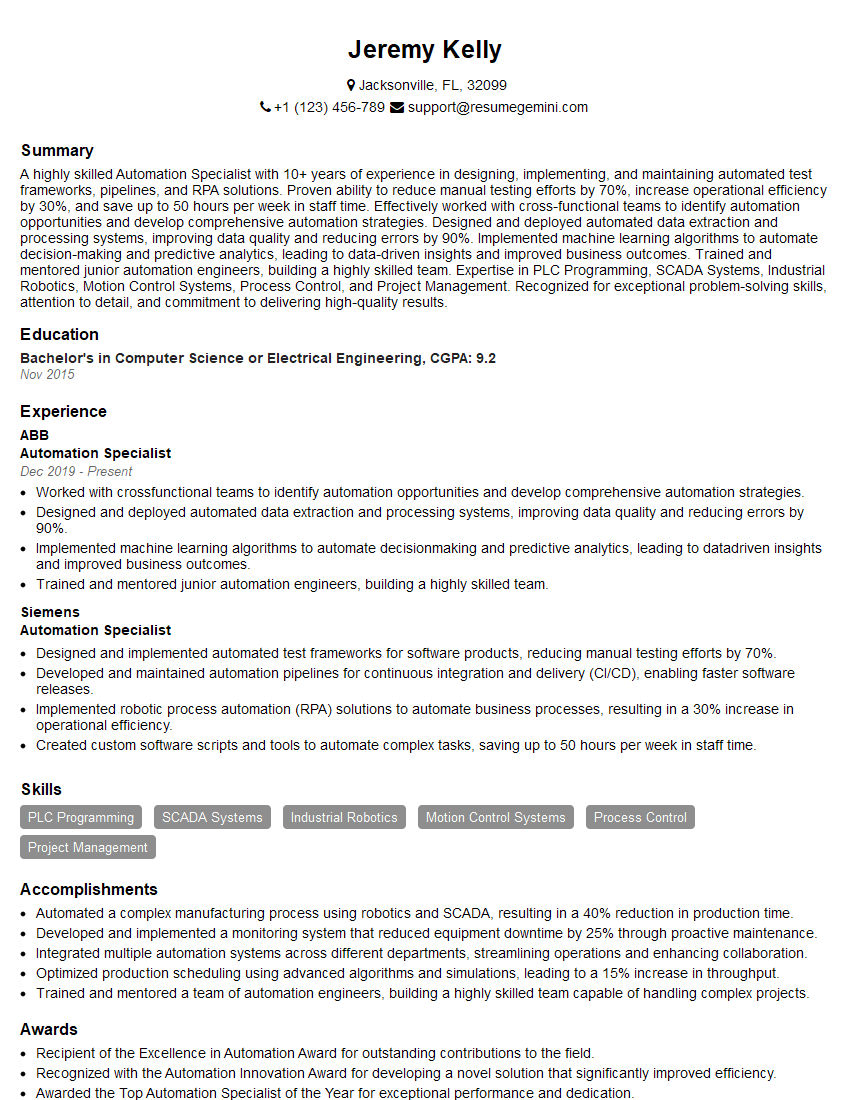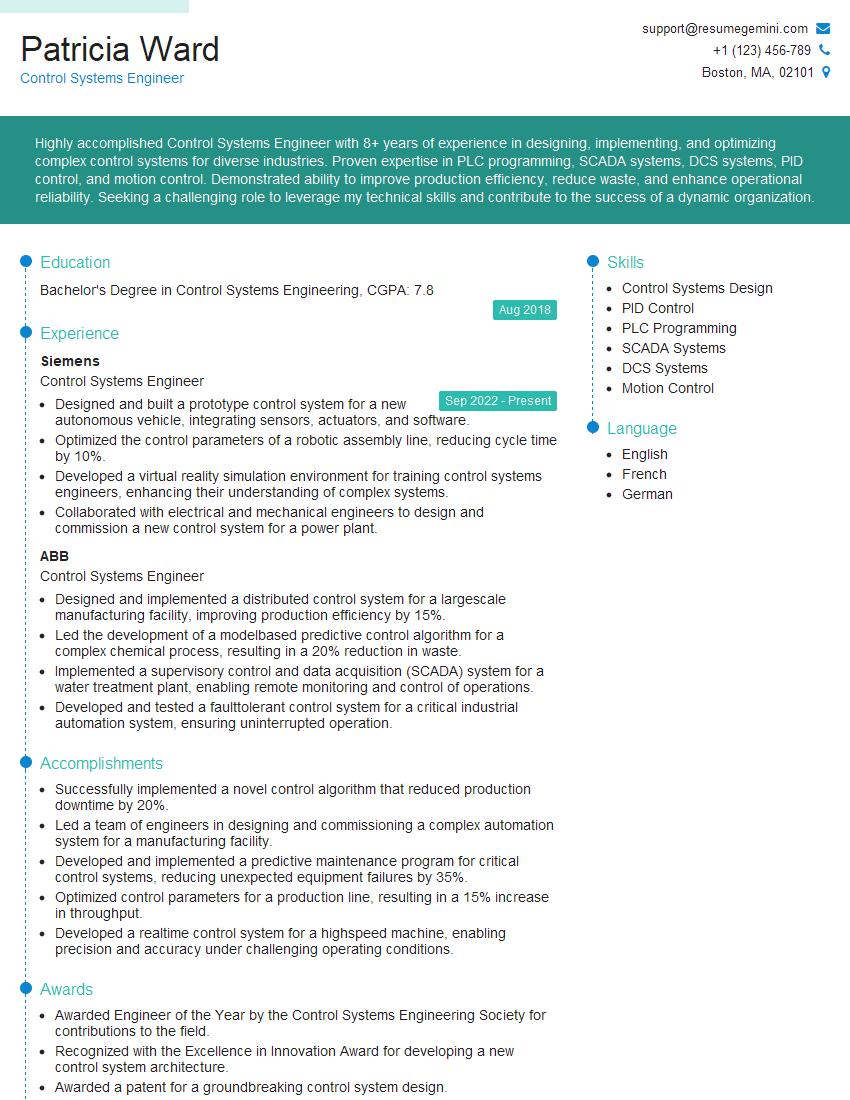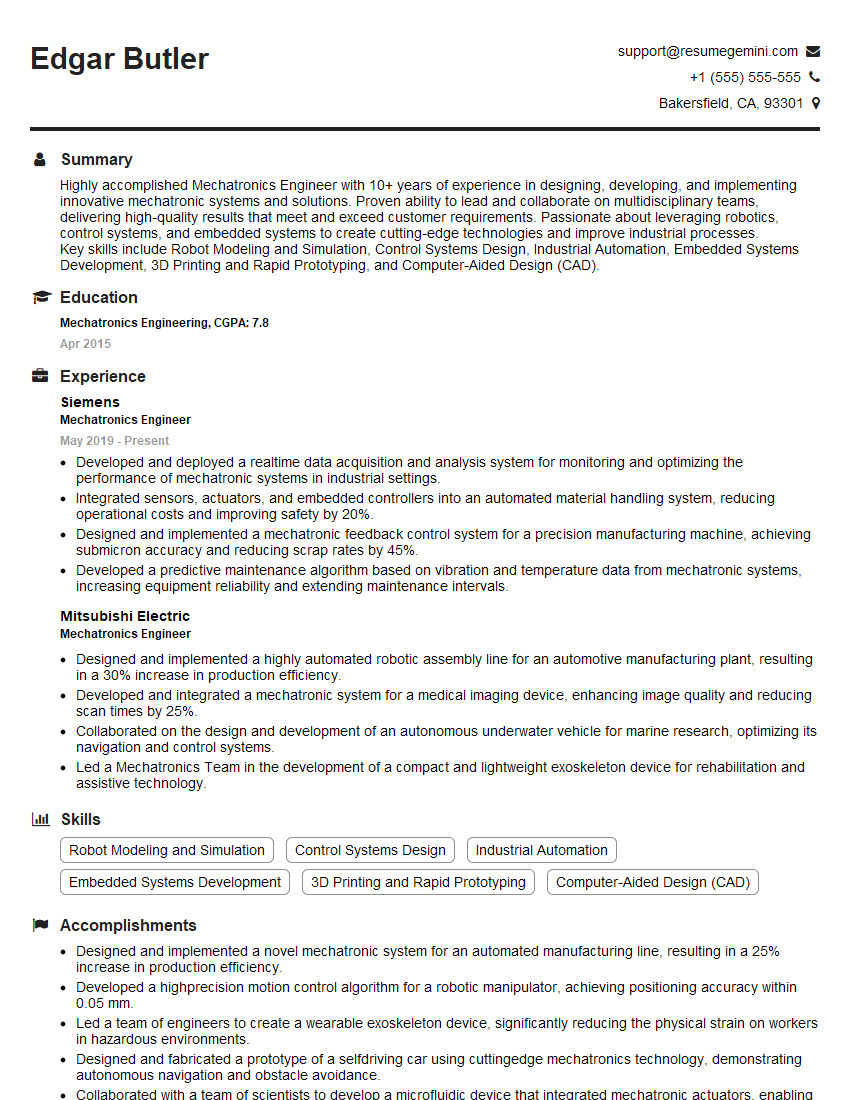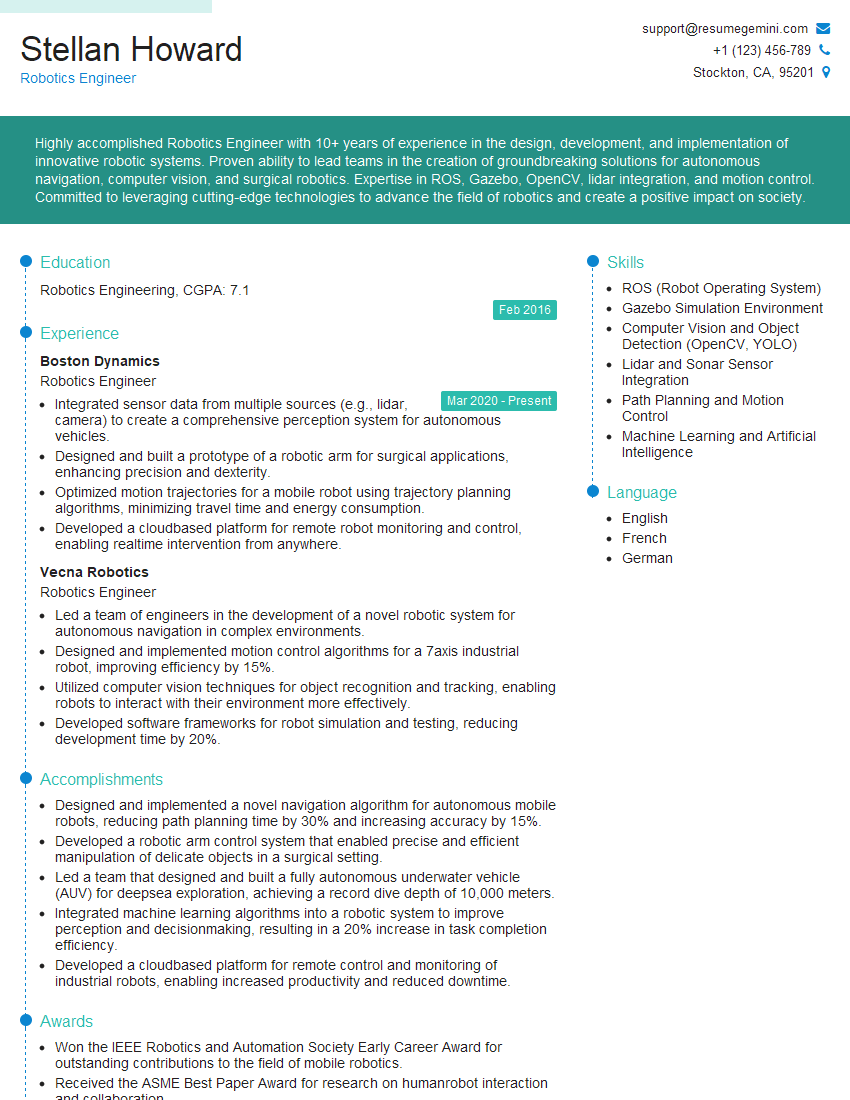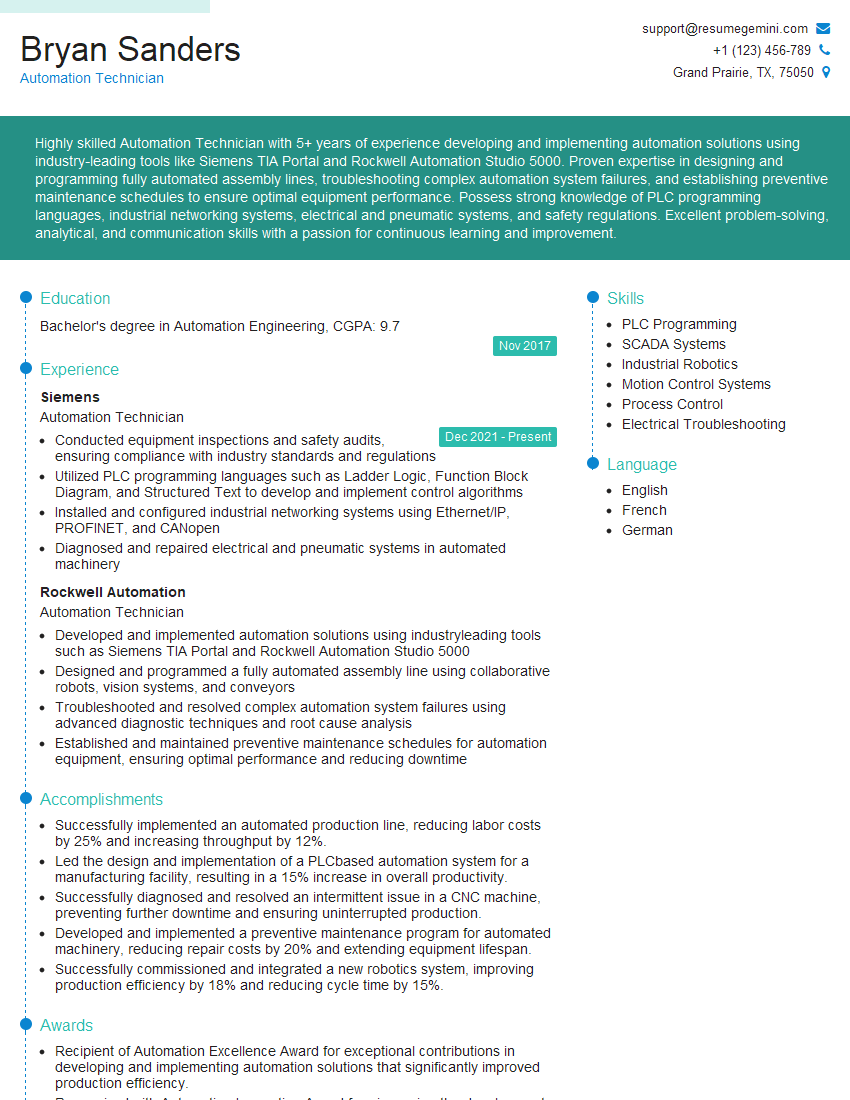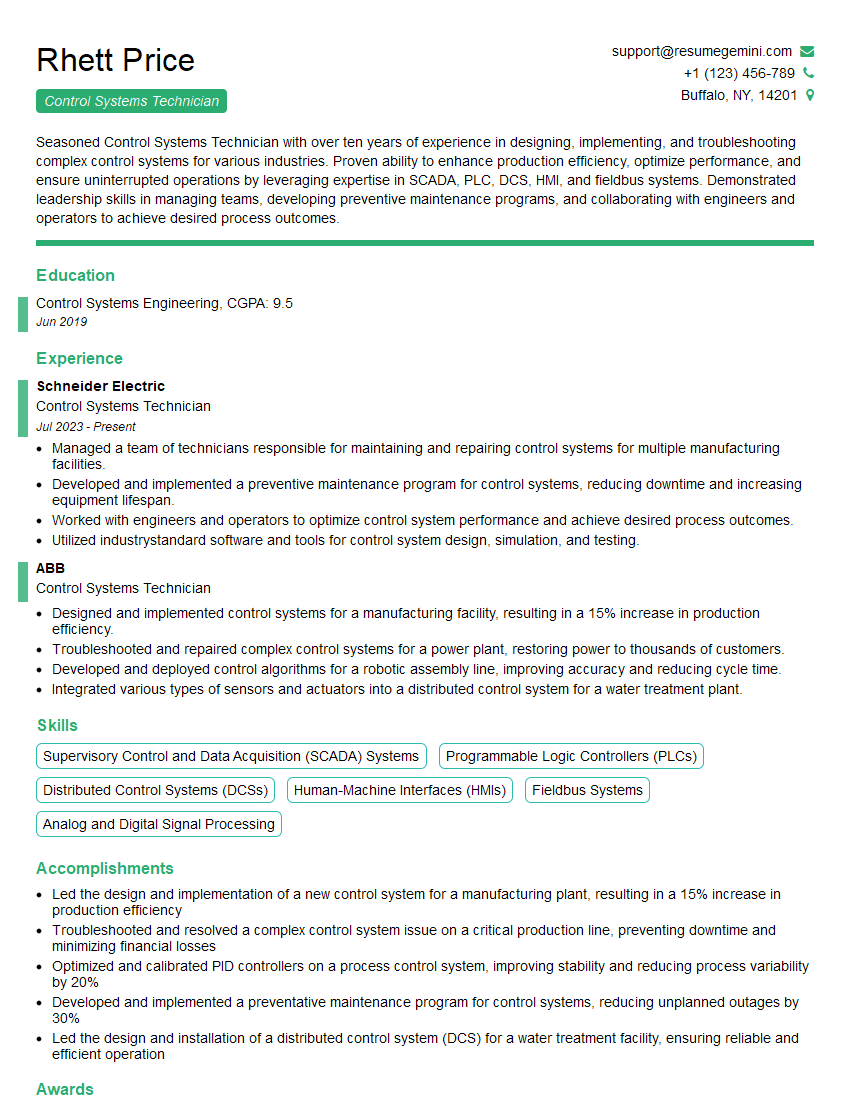Cracking a skill-specific interview, like one for Mitsubishi FX Series, requires understanding the nuances of the role. In this blog, we present the questions you’re most likely to encounter, along with insights into how to answer them effectively. Let’s ensure you’re ready to make a strong impression.
Questions Asked in Mitsubishi FX Series Interview
Q 1. Explain the difference between a timer and a counter in Mitsubishi FX PLC.
In Mitsubishi FX PLCs, timers and counters are both used for timing and counting events, but they operate fundamentally differently. Think of a timer as a stopwatch, measuring a specific duration, while a counter acts like a tally counter, incrementing or decrementing based on events.
Timers measure time. They start when a condition is met and stop when a preset time is reached. The FX series offers various timer types, including:
- TON (Timer ON Delay): This timer starts timing only when the input turns ON and continues to time even if the input turns OFF. The output turns ON only after the preset time has elapsed.
- TOF (Timer OFF Delay): This timer starts timing when the input turns OFF. The output remains ON until the preset time has elapsed.
- TP (Timer Pulse): This timer provides a single pulse of a specified duration when the input turns ON. The output turns ON for the preset time and then turns OFF.
Counters count events. They increment or decrement their value based on the state of input signals. The FX series offers:
- CNT (Counter): This is a simple up-counter that increments each time a specified input goes from OFF to ON.
- CNR (Down Counter): This counter decrements each time a specified input goes from OFF to ON.
Example: Imagine a conveyor belt system. A TON timer might be used to ensure a product spends enough time on the belt for processing, while a CNT counter could track the number of products passing a sensor.
Q 2. Describe the function of the various data types in Mitsubishi FX PLC (e.g., INT, DINT, REAL).
Mitsubishi FX PLCs utilize various data types to handle different kinds of information. Choosing the correct data type is crucial for efficient programming and prevents errors.
- INT (Integer): This is a 16-bit signed integer, representing values from -32,768 to 32,767. It’s perfect for simple counting or representing quantities.
- DINT (Double Integer): A 32-bit signed integer, ranging from -2,147,483,648 to 2,147,483,647. Useful for larger counts or when more precision is needed.
- REAL (Floating-Point): A 32-bit floating-point number, allowing for decimal values. Essential for applications requiring precision, like temperature control or analog input processing. Keep in mind that floating-point operations can be slower than integer operations.
Example: You might use an INT to count the number of parts produced, a DINT to track a large inventory count, and a REAL to represent the measured temperature from a sensor.
Q 3. How do you handle interrupts in a Mitsubishi FX PLC program?
Interrupt handling in Mitsubishi FX PLCs provides a mechanism for responding to high-priority events asynchronously. This means the PLC can react immediately to an event without waiting for the main program cycle to complete.
The FX series supports various interrupt sources, typically hardware-triggered, like:
- High-speed counters: Triggered when a high-speed counter reaches a preset value.
- Input changes: An interrupt may be triggered when a specific input changes state.
- Communication interrupts: Occur during communication events, like the completion of a data transfer.
Interrupt routines are separate subroutines that are executed when their corresponding interrupt occurs. Properly structuring and prioritizing interrupt routines is crucial to prevent conflicts and ensure timely responses to critical events. The priority of interrupt handling is predefined within the PLC itself.
Example: In a safety-critical application, a sensor detecting an emergency condition might trigger an interrupt, immediately stopping a machine before a potential hazard occurs.
Q 4. Explain the use of different addressing modes in Mitsubishi FX PLC.
Addressing modes in Mitsubishi FX PLCs determine how data memory locations are referenced in instructions. Efficient use of addressing modes enhances code clarity and improves performance.
- Immediate addressing: The data value is directly included within the instruction.
MOV K10 D100(Moves the value 10 to data register D100). - Direct addressing: The address of the data is directly specified in the instruction.
MOV M10 D100(Moves the contents of internal relay M10 to D100). - Indirect addressing: The address of the data is contained in another register, providing flexibility. For example, using an index register,
MOV [V100] D100(Moves the contents of the memory location pointed to by the value in V100 to D100).
Example: Imagine needing to move data to multiple memory locations. Using indirect addressing with a loop instruction makes this efficient, avoiding repetitive code.
Q 5. Describe your experience with Mitsubishi FX PLC programming software (GX Developer, GX Works3).
I have extensive experience with both GX Developer and GX Works3, Mitsubishi’s PLC programming software. GX Developer was my primary tool for many years, working on numerous FX series projects involving machine control, process automation, and data acquisition systems. I’m also proficient in GX Works3, the newer software, which offers improved features such as enhanced debugging tools and a more intuitive interface. My experience includes creating and modifying programs for various FX PLC models, from the simpler FX0 to the more advanced FX3U and FX3G series.
I’m adept at using the software’s features for tasks such as online monitoring, debugging with breakpoints and watch windows, and using the simulation functions for program testing before deployment to the actual PLC. I’ve utilized various programming techniques like structured text, ladder logic, and statement list, tailoring my approach based on the project requirements.
Q 6. How do you troubleshoot a PLC program that is not functioning correctly?
Troubleshooting a malfunctioning PLC program requires a systematic approach. My strategy typically involves these steps:
- Examine the error messages: The PLC may provide error codes or messages indicating the problem’s source.
- Review the program logic: Carefully check the ladder logic or other programming code, searching for logical errors, incorrect addressing, or timing issues. I often use the software’s simulation capabilities at this stage.
- Monitor input and output signals: Use the PLC’s online monitoring tools to observe the state of input sensors, internal relays, and output actuators. This helps identify discrepancies between expected and actual behavior.
- Check wiring and hardware: Physical issues such as faulty wiring, bad sensors, or damaged output modules can also cause problems. This includes visual inspections and checks with multimeters.
- Test individual sections of the code: Break down the program into smaller, manageable chunks to isolate the faulty section.
- Utilize the PLC’s built-in diagnostics: Many FX PLCs offer self-diagnostic features that pinpoint hardware issues.
Example: Recently, I encountered a situation where a conveyor belt stopped unexpectedly. Through systematic troubleshooting, we identified a faulty proximity sensor causing incorrect program behavior. Replacing the sensor resolved the issue.
Q 7. Explain the process of uploading and downloading programs to a Mitsubishi FX PLC.
Uploading and downloading programs to a Mitsubishi FX PLC is a standard procedure using the GX Developer or GX Works3 software. Here’s the process:
- Establish communication: Connect your computer to the PLC using a communication cable (usually RS-232 or Ethernet). Configure the communication settings within the software to match the PLC’s settings.
- Upload (Download): In GX Developer or GX Works3, select the appropriate PLC model. Use the software’s ‘Online’ mode to connect to the PLC. Select the ‘Download’ function to send your program to the PLC or ‘Upload’ function to copy the PLC’s program to your computer for backup or modification.
- Verify the transfer: After the download or upload is complete, the software will confirm success. It’s crucial to verify the program is correctly transferred by monitoring its operation.
- Monitor and debug (optional): Once downloaded, use the software’s online monitoring functions to verify the PLC’s operation and troubleshoot if necessary.
Important notes: Always back up your programs regularly. Ensure the PLC is in the correct mode (programming mode) before attempting to upload or download. Incorrect settings or interruption during the transfer process may corrupt the PLC program or cause damage.
Q 8. What are the different types of communication protocols supported by Mitsubishi FX PLCs?
Mitsubishi FX series PLCs offer a variety of communication protocols, catering to diverse industrial needs. The specific protocols available depend on the PLC model and any optional communication modules installed. Common protocols include:
- RS-232C: A serial communication standard used for point-to-point connections, often for connecting to a computer for programming or monitoring. Think of it as a simple, one-on-one conversation between the PLC and another device.
- RS-485: Another serial communication standard but allows for multi-point communication, meaning you can connect multiple devices to a single RS-485 network. This is more efficient for larger systems where multiple devices need to communicate with the PLC.
- Ethernet: Modern FX PLCs often support Ethernet communication, providing high-speed data transfer and the ability to connect to larger industrial networks. This is analogous to a high-speed internet connection for your PLC, enabling sophisticated data exchange and remote access.
- MELSECNET/H: Mitsubishi’s proprietary high-speed network protocol, enabling fast communication between multiple Mitsubishi PLCs and other devices within a factory automation system. It’s like having a dedicated, fast-lane network for your Mitsubishi equipment.
- Profibus DP: A widely used fieldbus protocol providing real-time communication in industrial automation. This allows for seamless integration with devices from other manufacturers that support Profibus.
Choosing the right protocol depends on factors like the distance between devices, the amount of data to be transmitted, and the overall network architecture. For instance, RS-232C is suitable for short distances and low data rates, whereas Ethernet is ideal for high-speed, long-distance communication.
Q 9. How do you implement a PID control loop in a Mitsubishi FX PLC?
Implementing a PID control loop in a Mitsubishi FX PLC involves using the PLC’s built-in math functions and timers. While the FX series doesn’t have dedicated PID function blocks like some higher-end PLCs, you can program it using ladder logic and the arithmetic instructions. The process involves:
- Reading Process Variable: First, you need to read the process variable (PV) from an analog input module. This represents the actual value you’re trying to control (e.g., temperature, pressure).
- Calculating Error: The error (E) is calculated by subtracting the setpoint (SP) from the PV:
E = SP - PV. - Calculating Proportional Term: The proportional term (P) is calculated by multiplying the error by the proportional gain (Kp):
P = Kp * E. Kp determines how aggressively the controller responds to the error. - Calculating Integral Term: The integral term (I) accumulates the error over time. This helps to eliminate steady-state error.
I = Ki * ∫E dt(where Ki is the integral gain and the integral is approximated using timers and accumulators in the PLC). - Calculating Derivative Term: The derivative term (D) anticipates future error by looking at the rate of change of the error.
D = Kd * dE/dt(where Kd is the derivative gain and the derivative is approximated using the difference between consecutive error values and timers). - Calculating Output: The output (OUT) is the sum of the P, I, and D terms:
OUT = P + I + D. This output is then scaled and sent to an analog output module to control the actuator (e.g., a valve, heater). - Auto-Tuning (Optional): Advanced PID tuning techniques can be implemented to optimize Kp, Ki, and Kd for the specific process.
This requires careful selection of the PID gains (Kp, Ki, Kd) based on the process characteristics. Incorrectly tuned gains can lead to instability or poor control. Often, a trial-and-error approach, or using auto-tuning features if available, is necessary.
Q 10. Explain the use of data registers and internal relays in Mitsubishi FX PLC.
Data registers and internal relays are fundamental elements in Mitsubishi FX PLC programming. They serve as memory locations to store data and control program execution.
- Data Registers (D registers): These are used to store numerical data, such as process values, setpoints, or intermediate calculations. They can hold 16-bit integer values. For instance,
D100might store the current temperature reading from a sensor. Think of them as labeled storage containers for numbers. - Internal Relays (M coils): These are internal bits (on/off) used for storing Boolean data (true/false) or controlling program flow. They act as flags or switches within the PLC. For example,
M10might indicate whether a motor is running (ON = 1, OFF = 0). These are essentially internal switches you manipulate through your ladder logic.
A simple example: Imagine a system where a motor starts when a sensor detects an object. You could use a sensor input to set an internal relay (e.g., M10) and then use M10 to control the motor output. The data register could then hold the count of detected objects.
Q 11. How do you use function blocks in Mitsubishi FX PLC?
While the FX series doesn’t have the extensive function block capabilities of higher-end PLCs, you can achieve similar functionality using subroutines and structured ladder logic. You essentially create modular blocks of code that perform specific tasks. This enhances code readability and reusability.
Consider a scenario where you need to perform a specific calculation multiple times within your program. Instead of writing the same code repeatedly, you could create a subroutine that performs that calculation. This subroutine would accept input values as arguments, perform the calculation, and return the result. You would then call this subroutine whenever needed, providing different input values each time.
This approach, though not explicitly function blocks in the same way as other PLC families, allows for similar modularity and code organization. It promotes better code management, especially in complex applications.
Q 12. Describe your experience with ladder logic programming.
I have extensive experience with ladder logic programming, spanning over [Number] years of working with various Mitsubishi FX series PLCs. My expertise includes designing, developing, debugging, and maintaining ladder logic programs for diverse industrial applications. I’m proficient in using all the common instructions, including timers, counters, arithmetic operations, and communication functions. I’ve worked on projects ranging from simple machine control to complex process automation systems.
For instance, in a recent project involving a packaging line, I developed a ladder logic program to control the conveyor belts, labeling machine, and product sorting system. This involved intricate coordination of timers, counters, and input/output signals to ensure smooth and efficient operation. My experience extends to troubleshooting existing programs, optimizing performance, and adapting programs to accommodate changes in system requirements.
I am comfortable using various Mitsubishi programming software and have experience with version control and documentation best practices.
Q 13. Explain the concept of self-holding contacts in Mitsubishi FX PLC.
Self-holding contacts, also known as self-latching contacts, create a memory function within a ladder logic program. Once activated, they remain active until explicitly deactivated. This is achieved by using a combination of normally open (NO) and normally closed (NC) contacts within the same rung.
Imagine a light switch. A regular switch turns the light on and off. A self-holding contact is like a switch that stays on until you flip a different switch to turn it off. In ladder logic, this is achieved with a NO contact that energizes an output (e.g., a motor), and an NC contact (connected to the same output) that holds that output ON even after the initial trigger condition is removed.
Example:
Let’s say I0.0 is a start button. Y0 controls a motor. A self-holding contact could be implemented as follows:[I0.0] --[NO]--[Y0]--[NC]--[Y0]
When I0.0 (start button) is pressed, Y0 (motor) is energized. The self-holding contact ([NC]--[Y0]) maintains Y0 energized, even after I0.0 is released. To stop the motor, you would need another input (e.g., a stop button) to break this self-holding circuit.
Q 14. How do you create and use user-defined functions in Mitsubishi FX PLC?
Mitsubishi FX PLCs allow the creation of user-defined functions (UDFs) through subroutines. These subroutines are blocks of code that perform a specific task, improving code organization and reusability. They’re essentially mini-programs within the larger PLC program.
To create a UDF, you define a subroutine in your ladder logic program. This subroutine can accept input parameters (e.g., data registers) and return results (e.g., stored in data registers). You then call this subroutine from your main program whenever you need to execute the specific task.
Example: Suppose you need to calculate the average of three temperature readings (stored in D100, D101, and D102). You could create a subroutine that performs this calculation. The subroutine would take D100, D101, and D102 as input, calculate the average, and store the result in another data register (e.g., D200). You would then call this subroutine from your main program to get the average temperature whenever needed. This makes the main program cleaner and more focused on the overall control logic.
Q 15. Describe your experience with analog input/output modules in Mitsubishi FX PLC.
Analog I/O modules in Mitsubishi FX PLCs allow interaction with real-world processes that produce continuous signals, unlike discrete on/off signals from digital I/O. These signals, such as temperature or pressure, are converted into digital values the PLC can understand. I have extensive experience working with various analog input modules, which typically measure voltage or current, and analog output modules, which control voltage or current outputs to actuators.
For instance, imagine controlling a temperature-sensitive process. An analog input module would read the temperature from a thermocouple, converting the millivolt signal into a digital representation. The PLC program then uses this digital value to control an analog output module, adjusting a heater’s power (voltage) to maintain the desired temperature. Different modules offer varying resolutions (number of bits) and accuracy, necessitating careful selection based on the application’s precision requirements. I’ve worked with modules ranging from 12-bit to 16-bit resolution, and selecting the right module involves careful consideration of noise immunity and the range of the analog signal.
Troubleshooting analog I/O often involves checking wiring, signal strength, grounding, and module configuration. For example, a noisy signal might lead to inaccurate readings, requiring careful shielding and grounding techniques. I’ve developed expertise in diagnosing these issues, often utilizing the PLC’s diagnostic capabilities and oscilloscopes to pinpoint problems.
Career Expert Tips:
- Ace those interviews! Prepare effectively by reviewing the Top 50 Most Common Interview Questions on ResumeGemini.
- Navigate your job search with confidence! Explore a wide range of Career Tips on ResumeGemini. Learn about common challenges and recommendations to overcome them.
- Craft the perfect resume! Master the Art of Resume Writing with ResumeGemini’s guide. Showcase your unique qualifications and achievements effectively.
- Don’t miss out on holiday savings! Build your dream resume with ResumeGemini’s ATS optimized templates.
Q 16. How do you handle data conversion between different data types in Mitsubishi FX PLC?
Data conversion between different data types is crucial in PLC programming. Mitsubishi FX PLCs handle various data types, including bits, words (16 bits), double words (32 bits), and floating-point numbers. The FX series utilizes specific instructions to facilitate these conversions.
For example, converting a word representing an analog input value (e.g., raw sensor reading) into an engineering unit (e.g., degrees Celsius) necessitates scaling and offset adjustments. This often involves using arithmetic instructions (ADD, SUB, MUL, DIV) and potentially bit manipulation.
Converting between integer and floating-point data requires specific instructions like DTW (Double Word to Floating Point) and WDT (Floating Point to Double Word). I’ve frequently used these instructions when dealing with precise sensor readings that need to be compared to setpoints in floating-point format for accurate control.
Example: Converting a 12-bit analog input (0-4095) to a 0-10V range would involve: Value = (Input_Value / 4095) * 10The use of data conversion is essential for handling data from different sources and presenting it in a usable format for program logic. Improper handling can lead to calculation errors or incorrect program execution.
Q 17. Explain the use of different instruction sets in Mitsubishi FX PLC.
Mitsubishi FX PLCs offer a comprehensive instruction set covering various logic, arithmetic, and control functions. These instructions are categorized into several groups, and my experience encompasses the use of numerous instructions across different applications.
- Basic Logic Instructions:
LD(Load),AND,OR,NOT,OUTare fundamental for implementing ladder logic diagrams and boolean operations. - Arithmetic Instructions:
ADD,SUB,MUL,DIV,INC,DECare crucial for performing calculations and data manipulation. - Comparison Instructions:
=(Equals),<>(Not Equals),>(Greater Than),<(Less Than) are used for conditional branching within the program. - Timers and Counters:
TIM(Timer),CNT(Counter) are essential for timing events and counting occurrences. - Data Movement Instructions:
MOV(Move),ZCP(Zero Clear and Pull) facilitate transferring data between memory locations. - Special Instructions: Various special instructions exist for specific functions, such as communication, PID control, and high-speed counting.
Choosing the right instruction set is crucial for efficient and maintainable code. For example, using bit manipulation instructions (AND, OR, NOT) can optimize code size and execution speed compared to more complex instructions.
Q 18. How do you implement safety features in a Mitsubishi FX PLC program?
Implementing safety features in a Mitsubishi FX PLC program requires careful consideration of potential hazards and the use of appropriate hardware and software techniques. The primary approach revolves around redundant safety measures, fail-safe mechanisms, and robust error handling.
Hardware-level safety might involve using safety relays and emergency stop circuits interfaced with the PLC. In the program, safety functions are implemented using dedicated safety instructions, if available within the PLC model, or through carefully designed logic. For example, an emergency stop button would trigger a direct signal to shut down critical parts of the machinery, bypassing any program logic that could potentially cause harm.
Software safety features include watchdog timers, which monitor the program's execution and trigger a shutdown if a fault is detected. I've extensively used these techniques to ensure safe operation. Moreover, error handling routines are crucial, and my experience involves implementing checks to detect inconsistencies or sensor failures and triggering safe shutdown procedures if necessary. Regular testing and verification of the safety system are paramount, involving simulations and thorough examination of the program's logic.
Q 19. Describe your experience with networking PLCs (e.g., using Ethernet/IP).
My experience with networking PLCs, specifically using Ethernet/IP, involves configuring Mitsubishi FX PLCs to communicate with other devices on an industrial Ethernet network. This often involves configuring communication parameters within the PLC, including IP address, subnet mask, and gateway address.
Ethernet/IP allows for data exchange between PLCs, HMI (Human Machine Interface) panels, and other devices. I've implemented various communication protocols, including using Ethernet/IP to transmit real-time data from multiple PLCs to a central supervisory system. For example, a manufacturing line with multiple PLCs controlling different stages can share production data to optimize overall efficiency. The FX series may require communication modules, such as Ethernet communication modules, to enable this capability.
Troubleshooting network issues involves checking network connectivity, IP addressing, and communication settings. Tools like network analyzers are essential in diagnosing network problems and ensuring seamless data flow. Efficient networking design involves selecting appropriate communication protocols and addressing data transmission rates to avoid delays and ensure reliable operation.
Q 20. How do you perform diagnostics on a Mitsubishi FX PLC?
Diagnostics on a Mitsubishi FX PLC can be performed using several methods. The built-in diagnostic features within the PLC are crucial for identifying faults. This might involve monitoring error flags, checking status bits, and examining the PLC's internal registers.
The PLC's programming software provides tools to monitor program execution, observe variable values, and examine program status. I often use these features to track down problems, and they provide real-time insight into the PLC's behavior. I use the software's debugging capabilities to step through the program and identify points of failure.
For more advanced troubleshooting, examining the PLC's internal logs can reveal past errors and provide valuable information for resolving recurring issues. In situations requiring further investigation, using specialized diagnostic tools or contacting technical support could be necessary. Proper documentation and regular maintenance are key in preventing issues and facilitating prompt diagnostics when problems arise.
Q 21. Explain your experience with different types of Mitsubishi FX PLC modules (e.g., input, output, communication).
My experience with Mitsubishi FX PLC modules spans a wide range of input, output, and communication types. I've worked extensively with digital I/O modules, providing discrete on/off control for various actuators and sensing devices. These range from basic 16-point modules to more specialized high-density models.
Analog I/O modules are frequently used in process control applications, as discussed previously. These modules handle continuous signals, and I've worked with diverse models to manage temperature, pressure, and flow measurements and control signals.
Communication modules are essential for networking the PLC. I've used various modules to enable communication via Ethernet/IP, serial ports, and other protocols. These modules are vital in integrating the PLC with SCADA systems and other automation components. For example, choosing the right communication module for high-speed data transmission requires careful consideration of the required bandwidth and communication protocol.
Selecting the appropriate modules is vital in designing a robust and effective control system. This involves considering factors like the number of I/O points, signal types, communication requirements, and the physical limitations of the environment.
Q 22. How do you program a counter to count up and down in Mitsubishi FX PLC?
Mitsubishi FX PLCs offer flexible counter functionalities. While they don't have a single instruction for both up and down counting simultaneously, you can achieve this using two counters or cleverly combining instructions. Let's explore both approaches.
Method 1: Using Two Counters
This is the simplest and most readable method. You'll use one counter (e.g., C100) to count up and another (e.g., C101) to count down. Each counter is triggered independently based on your process logic. For example:
LD X0(Input X0 triggers upward counting)+C C100(Increment counter C100)LD X1(Input X1 triggers downward counting)-C C101(Decrement counter C101)
Method 2: Using One Counter and Conditional Logic
This method uses a single counter but requires more complex logic. You'll need an additional bit to control the counting direction. Let's say M100 acts as a direction flag (M100=ON for up, M100=OFF for down):
LD X0(Input X0 starts counting)AND M100(Check if counting up)+C C100(Increment C100 if M100 is ON)LD X0AND NOT M100(Check if counting down)-C C100(Decrement C100 if M100 is OFF)
Remember to set the counter's reset condition (e.g., using a separate input or reaching a preset value). Choosing between these methods depends on the complexity of your application and readability preferences. The two-counter approach is generally preferred for its clarity.
Q 23. What are the advantages and disadvantages of using different programming languages for Mitsubishi FX PLC?
Mitsubishi FX PLCs primarily support ladder diagram (LD) programming. While some models offer options for structured text or instruction list, LD remains the most common and often preferred method. Let's compare:
- Ladder Diagram (LD): Advantages include its intuitive graphical representation, easy understanding, and widespread acceptance within the PLC industry. Disadvantages: Can become complex and less readable for large, intricate programs. Debugging can be slightly more challenging compared to textual languages.
- Structured Text (ST): Advantages: Excellent for complex logic, allows for reusable code blocks (functions and procedures), and is highly readable. Disadvantages: Requires programming knowledge beyond basic PLC understanding, may not be supported by all FX series PLCs.
- Instruction List (IL): Advantages: Compact, efficient for small programs. Disadvantages: Less readable than LD or ST, not suitable for complex applications, harder to debug.
In practice, for most Mitsubishi FX PLC applications, especially those involving simpler control processes, LD is the most efficient and user-friendly option. As complexity increases, ST becomes a powerful alternative to improve code maintainability and reduce errors. I've personally found that a blend of LD for the main control flow and ST for reusable subroutines often offers the best of both worlds.
Q 24. Explain the concept of program organization and structure in Mitsubishi FX PLC.
Program organization in a Mitsubishi FX PLC is crucial for maintainability and efficient troubleshooting. The FX series uses a linear program structure where instructions are executed sequentially unless modified by jump or branch instructions. Key aspects include:
- Network Structure: The program is divided into networks, each representing a logical section of the control system. Each network begins with a power rail (represented by a vertical line) and ends with a power rail.
- Instruction Ordering: Instructions within a network are executed from left to right and top to bottom. This sequential execution is fundamental to understanding the program's flow.
- Comments and Documentation: Adding comments to your code is vital. These explain the purpose of each network or instruction section, making it significantly easier for others (and your future self!) to understand the logic.
- Use of Function Blocks (if supported): If your PLC model supports them, function blocks can help structure the code into modular, reusable units. This enhances maintainability and reduces redundancy.
For example, a well-organized program might have separate networks for input processing, machine state control, output actions, and error handling. This modular approach makes it much simpler to identify and address issues within specific parts of the program.
Q 25. How do you use timers to control the sequence of operations in a Mitsubishi FX PLC?
Timers are essential for sequencing operations in Mitsubishi FX PLCs. The FX series provides various timer types, the most common being the TON (Timer ON Delay) and TOF (Timer OFF Delay).
TON (Timer ON Delay): This timer starts counting when its input becomes ON and remains active until the preset time elapses, even if the input turns OFF during the timing period.
Example: Suppose you need to activate a motor (output Y0) after a 5-second delay when a start button (input X0) is pressed. The code would look like this:
LD X0 TON T10 5 OUT Y0Here, T10 is a timer with a preset of 5 seconds. Y0 will turn ON after 5 seconds only if X0 remains ON. T10's status can be checked (e.g., T10.Q will be 1 when the timer is done).
TOF (Timer OFF Delay): This timer starts counting when its input turns OFF and remains active until the preset time elapses. It's useful for creating delays after an event ends.
Using timers in sequence involves chaining them or using their outputs to trigger other timers or actions. For instance, you can use the output of one timer to initiate another, creating a timed sequence of events.
Q 26. Describe your experience with troubleshooting hardware issues related to Mitsubishi FX PLCs.
My experience with troubleshooting Mitsubishi FX PLC hardware involves a systematic approach. I always start with the basics:
- Visual Inspection: Carefully examine all connections, looking for loose wires, damaged components, or burn marks.
- Power Supply Check: Verify that the PLC is receiving the correct voltage and that there are no power supply issues.
- Input/Output Testing: Test the inputs and outputs using a multimeter or PLC programming software's diagnostic tools to ensure they're functioning correctly. I'd check for shorts, opens, and incorrect wiring.
- Module Diagnostics: If your PLC has diagnostic capabilities, use the built-in functions to identify faulty modules. This is especially helpful in identifying problems with specific input/output modules or communication modules.
- Communication Check: If the PLC is part of a larger system, check communication links (e.g., Ethernet, serial) to ensure proper connectivity and data transfer. This often involves checking network cables, configurations, and communication settings.
I recall one instance where a seemingly simple production line stopped. After systematically checking, I discovered a loose connection on a crucial input module. A simple tightening resolved the issue, highlighting the importance of thorough visual inspection.
Q 27. How would you approach debugging a complex Mitsubishi FX PLC program?
Debugging a complex Mitsubishi FX PLC program requires a methodical approach. Here's my strategy:
- Understand the Program Logic: Thoroughly review the program's code, diagrams, and documentation to comprehend the intended functionality.
- Use Diagnostic Tools: Leverage the PLC's built-in monitoring and diagnostic functions. Monitor the status of internal bits, timers, and counters to trace the program's execution flow.
- Force Inputs/Outputs: Use the programming software's functionalities to simulate inputs and observe the resulting outputs. This helps isolate sections of the code that might be malfunctioning.
- Step-by-Step Execution: If necessary, use the PLC's step-by-step debugging mode to execute the program one instruction at a time. This allows for precise tracking of the program's flow and identification of errors.
- Isolate the Problem: By strategically monitoring and testing, narrow down the problem area to a specific section of the code or a group of instructions.
- Systematic Code Review: Once the problematic section is identified, carefully examine the code for logical errors, incorrect conditions, or timing issues.
- Simulate the Problem: If possible, create a simulated environment to reproduce the issue, which can help refine the debugging process and test potential solutions.
One approach is to divide and conquer. Break down the complex program into smaller, more manageable sections and debug them individually. The process involves careful observation, systematic testing, and a thorough understanding of the PLC's hardware and software.
Key Topics to Learn for Mitsubishi FX Series Interview
- PLC Programming Fundamentals: Understanding ladder logic diagrams, timers, counters, and basic instructions is crucial. Practice creating simple programs to control simulated outputs.
- Input/Output (I/O) Modules and Configuration: Learn how to configure and troubleshoot various I/O modules, understanding the different types and their applications in industrial automation systems. This includes practical experience with wiring and connecting devices.
- Communication Protocols: Familiarize yourself with common communication protocols used with the FX series, such as RS-232, RS-485, and Ethernet. Practice configuring and troubleshooting communication between PLCs and other devices.
- Program Organization and Debugging: Learn effective techniques for organizing large PLC programs and efficiently debugging code. Master the use of monitoring tools and troubleshooting methodologies.
- Advanced Instructions and Functions: Explore more advanced instructions such as data handling, mathematical functions, and PID control. Understanding these will showcase your deeper knowledge of the system.
- Safety and Security Considerations: Learn about safety standards and best practices for PLC programming, especially concerning industrial safety and security protocols within the Mitsubishi FX series.
- Troubleshooting and Diagnostics: Practice identifying and resolving common issues in PLC programs and hardware, using diagnostic tools and techniques specific to the FX Series.
- Real-world Applications: Familiarize yourself with typical applications of Mitsubishi FX Series PLCs in various industries (e.g., manufacturing, process control). Being able to relate theoretical concepts to practical scenarios will be highly beneficial.
Next Steps
Mastering the Mitsubishi FX Series significantly enhances your prospects in industrial automation and control systems. It demonstrates a valuable skillset highly sought after by employers. To maximize your chances, a well-crafted resume is essential. An ATS-friendly resume is key to getting past applicant tracking systems and landing interviews. We strongly encourage you to utilize ResumeGemini to build a professional and effective resume that highlights your Mitsubishi FX Series expertise. ResumeGemini provides examples of resumes tailored to Mitsubishi FX Series roles, helping you present your skills and experience in the most impactful way.
Explore more articles
Users Rating of Our Blogs
Share Your Experience
We value your feedback! Please rate our content and share your thoughts (optional).
What Readers Say About Our Blog
This was kind of a unique content I found around the specialized skills. Very helpful questions and good detailed answers.
Very Helpful blog, thank you Interviewgemini team.
